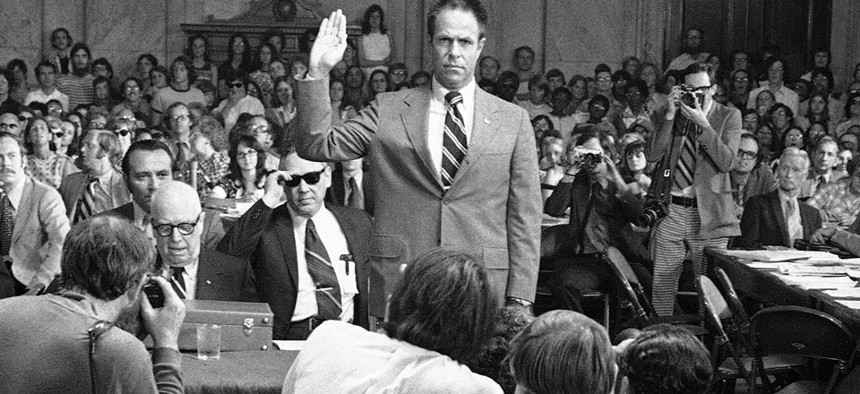
H.R. Haldeman, former chief of staff to President Nixon, is sworn in before the Senate Watergate Committee in 1973. Bob Daugherty/AP file photo
The Power Of Panels, Probes and Pardons
Federal investigations are on the rise since Watergate. But can they effect change in an era of polarized government?
When federal witnesses get hauled before the cameras, it’s sometimes a sign of historic high crimes and misdemeanors, and sometimes it’s merely partisan posturing and shooting blanks.
Longtime scholar and government reform advocate Paul C. Light set out to determine which of some 100 federal investigations during the past seven decades had high impact and which were duds.
“The central question is not whether there will be new issues to investigate or even whether the president will launch a blue-ribbon commission to straighten out some wayward program,” he said in a recent paper drawn from his book, Government by Investigation: Congress, Presidents and the Search for Answers, 1945-2012 (The Brookings Institution and the Governance Institute, 2013). “Rather, it is whether, in this era of polarized, divided government, the new investigations will be both done right and done well—that is with skill and impact.”
Light, a professor of public service at New York University, concludes that
good investigations are possible even under divided government.
Carefully laying out his evaluation criteria, Light compares investigations across time, investigatory characteristics and party control, as well as “institutional home” (House, Senate, presidency) and triggering event. Interestingly, the number of investigations has increased since the Watergate era, as has the quality of the probes—partisan gridlock notwithstanding.
Light’s list of the five investigations with the heaviest impact includes:
- 1975 probe of intelligence agency abuses
- 1981 Social Security crisis
- Sept. 11, 2001, terrorist attacks
- 2008 financial collapse
- 1947 government reorganization
Probes with the lightest impact:
- President Ford’s pardon of President Nixon in 1974
- Wedtech Corp. defense procurement decisions in 1986
- The 1980 presidential electio
- “October Surprise”
- Secret arms shipments to Bosnia in 1996
- The 2001 White House energy task force
In singling out investigative leaders who may be more fury than substance, Light is particularly tough on House Oversight and Government Reform Committee Chairman Rep. Darrell Issa, R-Calif. “I don’t think his investigations measure up,” Light said during a December 2013 appearance at the Brookings Institution in Washington. Issa’s investigations “tend not to be particularly thorough. It’s not clear where he’s going beyond the hunt for visibility.”
Light notes six patterns in federal investigations since World War II:
- Congress remains the “go-to” destination for launching investigations
- After Watergate, the House surpassed the Senate as the most active investigatory chamber
- Investigations triggered by events such as 9/11 or the banking collapse may have crowded out investigations sparked by routine oversight
- Investigations of process failures and misconduct may be driving out investigations of policy breakdowns
- Many post-Watergate investigations were salvage operations focused on repairing failing programs and ossified agencies.
- Investigators may be losing their fact- finding skills
NEXT STORY: Fighting The Future Enemy







